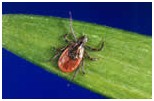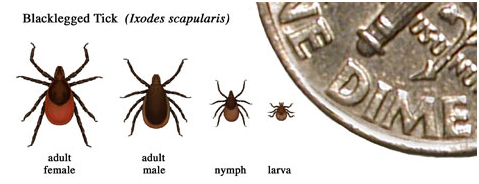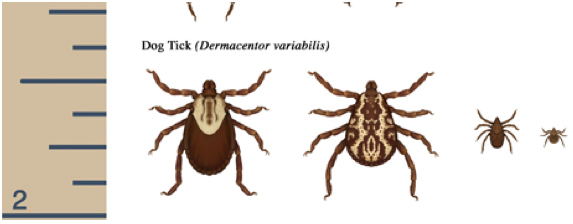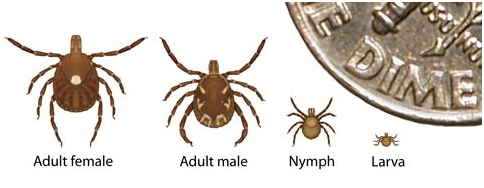 As the weather gets warmer this spring, people have already started to spend more time outside. Warmer weather also means that ticks will soon become more active, increasing the chance of having a tick bite if you spend time in certain outdoor areas. Ticks can carry different kinds of diseases, so you should be aware of how to protect yourself from bites and what symptoms to watch for if you have been bitten. The tick-borne diseases that occur most often in Virginia are:
As the weather gets warmer this spring, people have already started to spend more time outside. Warmer weather also means that ticks will soon become more active, increasing the chance of having a tick bite if you spend time in certain outdoor areas. Ticks can carry different kinds of diseases, so you should be aware of how to protect yourself from bites and what symptoms to watch for if you have been bitten. The tick-borne diseases that occur most often in Virginia are:
Lyme Disease
The Tick
- The blacklegged tick (Ixodes scapularis), formerly known as the deer tick, is the only carrier of Lyme disease in the Eastern U.S.
- An infected tick must be attached to a human for 36 hours or more to transmit lyme disease.

Symptoms:
- Most patients (about 75%) will see the development of a red rash called an erythema migrans (“EM” or “bull’s-eye” rash) around a tick bite site within days or weeks of the tick bite. This rash expands (up to 12 inches in diameter) and often clears around the center. The rash does not itch or hurt, so it may not be noticed if it is on a person’s back-side or scalp.
- The initial illness may cause fatigue, fever, headache, muscle and joint pains, and swollen lymph nodes.
Treatment:
- When Lyme disease is detected early and treated with an appropriate antibiotic (e.g., doxycycline), it is easily cured.
Rocky Mountain Spotted Fever (RMSF)
The Tick
- RMSF is transmitted to humans by the bite of an infected American dog tick.
- The infected tick must be attached to a human for only about four hours to transmit the bacteria.

Symptoms:
- RMSF is characterized by a sudden onset of moderate to high fever (which can last for 2 or 3 weeks), severe headache, fatigue, deep muscle pain, chills and rash.
- The rash begins on the legs or arms, may include the soles of the feet or palms of the hands and may spread rapidly to the trunk or rest of the body.
Treatment
- Certain antibiotics such as tetracycline or chloramphenicol may be effective in treating the disease.
- RMSF can be fatal, so if you are concerned about symptoms, contact your doctor immediately.
Ehrlichiosis
The Tick
- Ehrilchiosis is transmitted by the Lone Star Tick and most commonly by adult Lone Star Ticks.
- An infected tick must be attached to a human for at least 24 hours to transmit disease.

The Symptoms
- Symptoms can include fever, headache, muscle pain, vomiting, and general discomfort.
- Illness can be severe and up to 3% of infected people can die if not treated.
Treatment
- Treatment will be determined based on symptoms, but ehrlichiosis responds rapidly to antibiotics.
To Protect Yourself From Tick Bites:
- While it is a good idea to take preventive measures against ticks year-round, be extra vigilant in warmer months (April-September) when ticks are most active.
- Avoid wooded and bushy areas with high grass and leaf litter.
- Walk in the center of trails.
- Use repellents that contain 20 to 30% DEET (N, N-diethyl-m-toluamide) on exposed skin and clothing for protection that lasts up to several hours. Always follow product instructions. Parents should apply this product to their children, avoiding hands, eyes, and mouth.
- Use products that contain permethrin on clothing. Treat clothing and gear, such as boots, pants, socks and tents. It remains protective through several washings. Pre-treated clothing is available and remains protective for up to 70 washings.
- Other repellents registered by the Environmental Protection Agency (EPA) may be found at http://cfpub.epa.gov/oppref/insect/.
- Bath or shower as soon as possible after coming indoors (preferably within two hours) to wash off and more easily find ticks that are crawling on you.
- Conduct a full-body tick check using a hand-held or full-length mirror to view all parts of your body upon return from tick-infested areas. Parents should check their children for ticks under the arms, in and around the ears, inside the belly button, behind the knees, between the legs, around the waist, and especially in their hair.
- Examine gear and pets. Ticks can ride into the home on clothing and pets, then attach to a person later, so carefully examine pets, coats, and day packs.
- Tumble clothes in a dryer on high heat for an hour to kill remaining ticks. (Some research suggests that shorter drying times may also be effective, particularly if the clothing is not wet.)
For more information on tick-borne diseases, please visit these sites:



